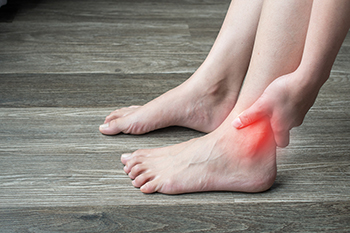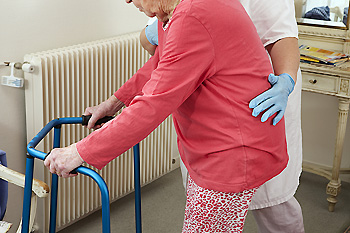
(908) 381-8160Berkeley Heights

If an ankle fracture is mistaken for an ankle sprain, it can have serious consequences on proper healing. An ankle fracture is when there is a crack or break in the bones that form the ankle joint. A sprain involves ligaments that hold the ankle bones together rather than harm the bones themselves. Both injuries can result from the ankle moving beyond its normal range of motion. However, a fracture requires more intense treatment than a sprain. Prolonged pain and bruising of the ankle are good indicators that the ankle may be broken. If you have injured your ankle and are unsure if it is broken or sprained, see a podiatrist who can properly differentiate these conditions and provide the best treatment.
Broken ankles need immediate treatment. If you are seeking treatment, contact Dr. Janet Leicht from New Jersey. Our doctor can provide the care you need to keep you pain-free and on your feet.
Broken Ankles
A broken ankle is experienced when a person fractures their tibia or fibula in the lower leg and ankle area. Both of these bones are attached at the bottom of the leg and combine to form what we know to be our ankle.
When a physician is referring to a break of the ankle, he or she is usually referring to a break in the area where the tibia and fibula are joined to create our ankle joint. Ankles are more prone to fractures because the ankle is an area that suffers a lot of pressure and stress. There are some obvious signs when a person experiences a fractured ankle, and the following symptoms may be present.
Symptoms of a Fractured Ankle
If you suspect an ankle fracture, it is recommended to seek treatment as soon as possible. The sooner you have your podiatrist diagnose the fracture, the quicker you’ll be on the way towards recovery.
If you have any questions, please feel free to contact our office located in Berkeley Heights, NJ . We offer the newest diagnostic and treatment technologies for all your foot care needs.

Anyone who has been jarred awake in the middle of the night by a toe, foot, or leg cramp knows how uncomfortable that can be. A cramp occurs when a muscle involuntarily contracts and is unable to relax. The intense pain caused by a cramp usually goes away, either on its own or by gently massaging or stretching the muscle that is affected. Athletes are most likely to experience foot and toe cramps after long bouts of exercise or other physical activity. High temperatures can also cause cramps from loss of electrolytes, which is a sign of dehydration. Wearing tight shoes or holding a specific position for a long period can bring on cramps, resulting from restricted blood flow. A more serious cause of cramps is arteriosclerosis, which is a constriction of blood flow to the extremities caused by a blockage in the arteries. In some cases, the cramping may be the result of diabetes, nerve damage, or Parkinson’s disease. Cramps may also be caused by deficiencies in certain minerals, such as potassium, calcium, and magnesium. If lower leg, foot, or toe cramps are becoming a regular occurrence, it is wise to visit a podiatrist for a diagnosis and possible treatment options.
Toe pain can disrupt your daily activities. If you have any concerns, contact Dr. Janet Leicht of New Jersey. Our doctor can provide the care you need to keep you pain-free and on your feet.
What Causes Toe Pain?
Most severe toe pain is caused due to a sports injury, trauma from dropping something heavy on the toe, or bumping into something rigid. Other problems can develop over time for various reasons.
Toe pain can be caused by one or more ailments. The most common include:
When to See a Podiatrist
Diagnosis
In many cases the cause of toe pain is obvious, but in others, a podiatrist may want to use more advanced methods to determine the problem. These can range from simple visual inspections and sensation tests to X-rays and MRI scans. Prior medical history, family medical history, and any recent physical traumatic events will all be taken into consideration for a proper diagnosis.
Treatment
Treatments for toe pain and injuries vary and may include shoe inserts, padding, taping, medicines, injections, and in some cases, surgery. If you believe that you have broken a toe, please see a podiatrist as soon as possible.
If you have any questions please feel free to contact our office located in Berkeley Heights, NJ . We offer the newest diagnostic tools and technology to treat your foot and ankle needs.

Plantar fasciitis is a widespread and important kind of foot affliction to be aware of. It is primarily developed when an individual’s plantar fascia, or band of tissue that runs along the arch of the foot, becomes inflamed and aggravated. Pain can be felt in the feet as a result. Importantly, this condition is distinctly different from sciatica, although they each cause some kind of foot pain. Sciatica, by contrast, can occur in an individual when certain nerves that are located in the back can become compressed. Due to the compression, sensations of pain and numbness can travel down the body into the feet. For more information about what makes plantar fasciitis different from sciatica, please contact a podiatrist today.
Plantar fasciitis is a common foot condition that is often caused by a strain injury. If you are experiencing heel pain or symptoms of plantar fasciitis, contact Dr. Janet Leicht from New Jersey. Our doctor can provide the care you need to keep you pain-free and on your feet.
What Is Plantar Fasciitis?
Plantar fasciitis is one of the most common causes of heel pain. The plantar fascia is a ligament that connects your heel to the front of your foot. When this ligament becomes inflamed, plantar fasciitis is the result. If you have plantar fasciitis you will have a stabbing pain that usually occurs with your first steps in the morning. As the day progresses and you walk around more, this pain will start to disappear, but it will return after long periods of standing or sitting.
What Causes Plantar Fasciitis?
There are some risk factors that may make you more likely to develop plantar fasciitis compared to others. The condition most commonly affects adults between the ages of 40 and 60. It also tends to affect people who are obese because the extra pounds result in extra stress being placed on the plantar fascia.
Prevention
There are a variety of treatment options available for plantar fasciitis along with the pain that accompanies it. Additionally, physical therapy is a very important component in the treatment process. It is important that you meet with your podiatrist to determine which treatment option is best for you.
If you have any questions, please feel free to contact our office located in Berkeley Heights, NJ . We offer the newest diagnostic and treatment technologies for all your foot care needs.

As an individual gets older they can become more susceptible to suffering from a detrimental fall. This might be caused by weakened foot muscles or neglect of caring for the feet. While senior citizens may experience falls in their homes or out shopping, seniors can also suffer falls at nursing care facilities too. It is estimated that approximately half of all elderly individuals in a long-term care environment fall each year. This is particularly helpful to be aware of because if you have a loved one in a long-term care facility, you might consider helping them take steps to care for and strengthen their feet so that they do not suffer a similar fate. Contact a podiatrist today for more information about preventing falls among seniors.
Preventing falls among the elderly is very important. If you are older and have fallen or fear that you are prone to falling, consult with Dr. Janet Leicht from New Jersey. Our doctor will assess your condition and provide you with quality advice and care.
Every 11 seconds, an elderly American is being treated in an emergency room for a fall related injury. Falls are the leading cause of head and hip injuries for those 65 and older. Due to decreases in strength, balance, senses, and lack of awareness, elderly persons are very susceptible to falling. Thankfully, there are a number of things older persons can do to prevent falls.
How to Prevent Falls
Some effective methods that older persons can do to prevent falls include:
Falling can be a traumatic and embarrassing experience for elderly persons; this can make them less willing to leave the house, and less willing to talk to someone about their fears of falling. Doing such things, however, will increase the likelihood of tripping or losing one’s balance. Knowing the causes of falling and how to prevent them is the best way to mitigate the risk of serious injury.
If you have any questions, please feel free to contact our office located in Berkeley Heights, NJ . We offer the newest diagnostic and treatment technologies for all your foot care needs.